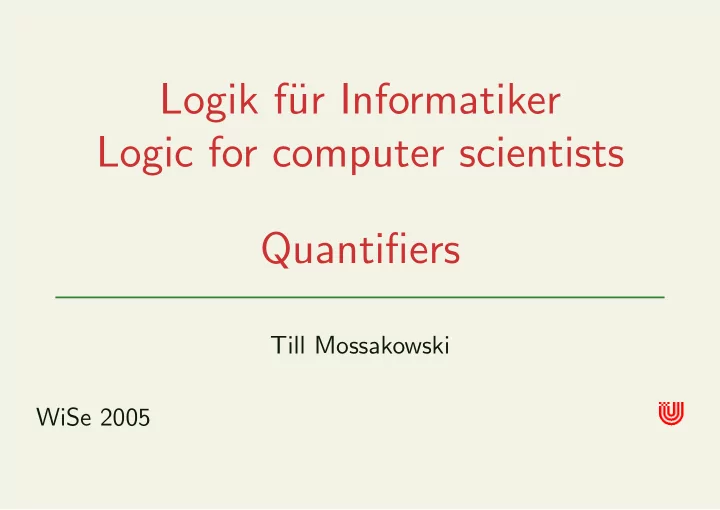

Logik f¨ ur Informatiker Logic for computer scientists Quantifiers Till Mossakowski WiSe 2005
2 Motivating examples ∀ x Cube ( x ) ( “All objects are cubes.” ) ∀ x ( Cube ( x ) → Large ( x )) ( “All cubes are large.” ) ∀ x Large ( x ) ( “All objects are large.” ) Till Mossakowski: Logic WiSe 2005
3 ∃ x Cube ( x ) “There exists a cube.” ∃ x ( Cube ( x ) ∧ Large ( x )) “There exists a large cube.” Till Mossakowski: Logic WiSe 2005
4 The four Aristotelian forms All P’s are Q’s. ∀ x ( P ( x ) → Q ( x )) Some P’s are Q’s. ∃ x ( P ( x ) ∧ Q ( x )) No P’s are Q’s. ∀ x ( P ( x ) → ¬ Q ( x )) Some P’s are not Q’s. ∃ x ( P ( x ) ∧ ¬ Q ( x )) Note: ∀ x ( P ( x ) → Q ( x )) does not imply that there are some P ′ s . ∃ x ( P ( x ) ∧ Q ( x )) does not imply that not all P ′ s are Q ′ s . Till Mossakowski: Logic WiSe 2005
5 First-order signatures A first-order signature consists of • a set of predicate symbols with arities, like Smaller (2) , Dodec (1) , Between (3) , ≤ (2) , including propositional symbols (nullary predicate symbols), like A (0) , B (0) , C (0) , (written uppercase) • its names or constants for individuals, like a, b, c , (written lowercase) • its function symbols with arities, like f (1) , + (2) , × (2) . Till Mossakowski: Logic WiSe 2005
6 Usually, arities are omitted. In the book, the terminology “language” is used. “Signature” is more precise, since it exactly describes the ingredients that are needed to generate a (first-order) language. Till Mossakowski: Logic WiSe 2005
7 Terms t ::= a constant t ::= x variable | f ( n ) ( t 1 , . . . , t n ) application of function symbols to terms Usually, arities are omitted. Till Mossakowski: Logic WiSe 2005
8 Well-formed formulas F ::= p ( n ) ( t 1 , . . . , t n ) application of predicate symbols | ⊥ contradiction | ¬ F negation | ( F 1 ∧ . . . ∧ F n ) conjunction | ( F 1 ∧ . . . ∨ F n ) disjunction | ( F 1 → F 2 ) implication | ( F 1 ↔ F 2 ) equivalence | ∀ νF universal quantification | ∃ νF existential quantification The variable ν is said to be bound in ∀ νF and ∃ νF . Till Mossakowski: Logic WiSe 2005
9 Parentheses The outermost parenthese of a well-formed formula can be omitted: Cube ( x ) ∧ Small ( x ) In general, parentheses are important to determine the scope of a quantifier (see next slide). Till Mossakowski: Logic WiSe 2005
10 Free and bound variables An occurrence of a variable in a formula that is not bound is said to be free. ∃ y LeftOf ( x, y ) x is free, y is bound ( Cube ( x ) ∧ Small ( x )) x is free, y is bound → ∃ y LeftOf ( x, y ) ∃ x ( Cube ( x ) ∧ Small ( x )) Both occurrences of x are bound ∃ x Cube ( x ) ∧ Small ( x ) The first occurrence of x is bound, the second one is free Till Mossakowski: Logic WiSe 2005
11 Sentences A sentence is a well-formed formula without free variables. ⊥ A ∧ B Cube ( a ) ∨ Tet ( b ) ∀ x ( Cube ( x ) → Large ( x )) ∀ x (( Cube ( x ) ∧ Small ( x )) → ∃ y LeftOf ( x, y )) Till Mossakowski: Logic WiSe 2005
12 Semantics of quantification We need to fix some domain of discourse. ∀ x S ( x ) is true iff for every object in the domain of discourse with name n , S ( n ) is true. ∃ x S ( x ) is true iff for some object in the domain of discourse with name n , S ( n ) is true. Not all objects need to have names — hence we assume that for objects, names n 1 , n 2 , . . . can be invented “on the fly”. Till Mossakowski: Logic WiSe 2005
13 The game rules Till Mossakowski: Logic WiSe 2005
14 Form Your commitment Player to move Goal you Choose one of true P ∨ Q P , Q that Tarski’s World is true. false Tarski’s World Choose one of true P ∧ Q P , Q that you is false. false Choose some b you true ∃ x P ( x ) that satisfies Tarski’s World the wff P(x) . false Choose some b Tarski’s World true ∀ x P ( x ) that does not you satisfy P(x) . false Till Mossakowski: Logic WiSe 2005
15 Till Mossakowski: Logic WiSe 2005
16 Replace ¬ P ¬ P either — by P and switch commitment. Replace P → Q P → Q either — by ¬ P ∨ Q and keep commitment. Replace P ↔ Q by P ↔ Q either — ( P → Q ) ∧ ( Q → P ) and keep commitment. Till Mossakowski: Logic WiSe 2005
Recommend
More recommend